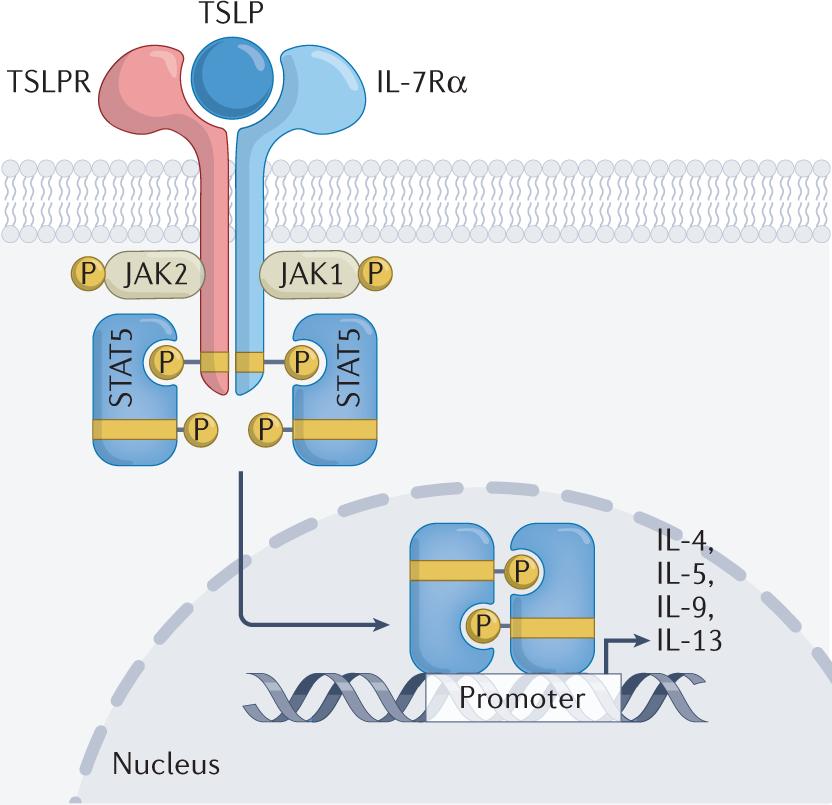What is TSLP Protein
Thymic Stromal Lymphopoietin, commonly known as TSLP, goes by various synonyms such as interleukin-7 receptor-activating cytokine, thymic stromal-derived lymphopoietin, and B cell growth factor-activating cytokine. This multifaceted protein belongs to the cytokine family, specifically interleukin-2 cytokine family, and plays a pivotal role in immune regulation and homeostasis.
TSLP Protein Structural Characteristics and Classification
TSLP is a glycoprotein with a molecular weight of approximately 25 kDa. Its gene is located on chromosome 5 in humans. Structurally, TSLP shares similarities with other cytokines, featuring a four-helix bundle structure. Its receptor, TSLPR, forms a heterodimer with the interleukin-7 receptor alpha (IL-7Rα) chain. This receptor complex is crucial for transmitting TSLP signals into cells.
Recent Research Advances about TSLP Protein
Recent research has delved into the intricate details of TSLP, shedding light on its diverse functions. Studies have elucidated its role in promoting dendritic cell maturation, leading to the initiation of T helper 2 (Th2) immune responses. Additionally, TSLP has been implicated in allergic diseases, highlighting its significance in the context of immunological disorders.
TSLP Biological Functions and Molecular Mechanisms
TSLP is a master orchestrator in the immune system, regulating both innate and adaptive immune responses. Its primary function is to stimulate dendritic cells, influencing their maturation and subsequent activation of CD4+ T cells, particularly Th2 cells. This activation cascade is pivotal in mounting immune responses against pathogens and allergens.
The molecular mechanisms underlying TSLP's actions involve the interaction with its receptor complex, TSLPR and IL-7Rα. Upon binding, a signaling cascade is initiated, activating various transcription factors and pathways. Notably, the activation of STAT5 and STAT6 is central to TSLP-mediated responses, leading to the expression of genes associated with inflammation and immune regulation.

Figure 1. Mechanisms of thymic stromal lymphopoietin-induced signaling. (Ebina-Shibuya R, et al., 2023)
TSLP Related Signaling Pathway
TSLP exerts its effects through a well-defined signaling pathway:
- Receptor Interaction: TSLP binds to its receptor complex, TSLPR/IL-7Rα, on the surface of target cells.
- Activation of STAT Pathways: Upon binding, the receptor complex activates STAT5 and STAT6, key signaling molecules, initiating downstream events.
- Gene Expression and Immune Response: Activated STAT proteins translocate to the nucleus, where they regulate the expression of genes associated with immune responses, inflammation, and tissue homeostasis.
TSLP Related Diseases
TSLP's intricate involvement in immune regulation makes it a key player in several diseases:
- Allergic Diseases: TSLP has been implicated in allergic disorders such as asthma, eczema, and allergic rhinitis. Its ability to skew immune responses towards Th2-type reactions contributes to the development and exacerbation of allergic conditions.
- Inflammatory Conditions: Inflammation, a hallmark of many diseases, is influenced by TSLP. Chronic inflammatory conditions, including inflammatory bowel disease (IBD) and certain skin disorders, often exhibit dysregulated TSLP signaling.
- Autoimmune Disorders: Emerging evidence suggests a link between TSLP and autoimmune diseases. Aberrant TSLP expression has been observed in conditions like rheumatoid arthritis, implicating its role in autoimmune pathogenesis.
TSLP's Applications in Biomedicine
Exploiting the properties of TSLP has promising applications in biomedical research and development:
- Diagnostic Development: TSLP levels can serve as biomarkers for certain allergic and inflammatory diseases. Monitoring TSLP expression allows for early detection and accurate diagnosis, aiding in the timely initiation of targeted therapies.
- Vaccine Development: Understanding TSLP's role in immune activation provides a basis for vaccine development. TSLP can be harnessed to enhance the efficacy of vaccines by promoting robust immune responses against pathogens.
- Therapeutics: Targeting TSLP signaling pathways presents a novel therapeutic approach for diseases with dysregulated immune responses. Modulating TSLP activity holds promise for the development of precision therapies, addressing the underlying causes of allergic, inflammatory, and autoimmune conditions.
Recommended Products
| Cat.# | Product name | Species | Source (Host) | Tag |
|---|---|---|---|---|
| TSLP-391H | Recombinant Human TSLP(R127A, R130A) protein, His-Avi-tagged | Human | HEK293 | His-Avi |
| TSLP-1391H | Active Recombinant Human TSLP protein, His-Avi-tagged, Biotinylated | Human | HEK293 | His-Avi |
| TSLP-372H | Recombinant Human TSLP protein, His-tagged | Human | HEK293 | His |
| TSLP-392H | Recombinant Human TSLP protein, His-Avi-tagged | Human | HEK293 | His-Avi |
| TSLP-0775H | Active Recombinant Human TSLP protein, mFc-tagged | Human | HEK293 | mFc |
| TSLP-8307H | Recombinant Human TSLP | Human | N/A | |
| TSLP-3627H | Recombinant Human TSLP protein, His-SUMO-tagged | Human | E.coli | His-SUMO |
| TSLP-6809H | Recombinant Human TSLP protein, His & T7-tagged | Human | E.coli | His/T7 |
| TSLP-258H | Active Recombinant Human TSLP Protein | Human | E.coli | |
| TSLP-4251H | Recombinant Human TSLP Protein, His (Fc)-Avi-tagged | Human | HEK293 | His (Fc)-Avi |
Reference
- Ebina-Shibuya R, Leonard W J. Role of thymic stromal lymphopoietin in allergy and beyon. Nature Reviews Immunology. 2023, 23(1): 24-37.

